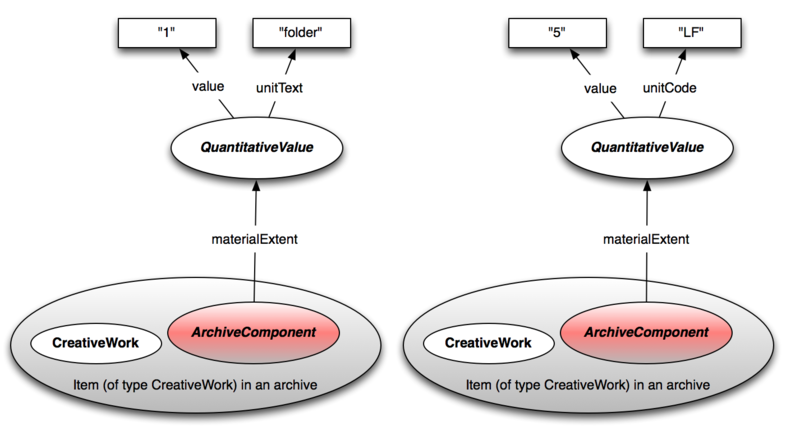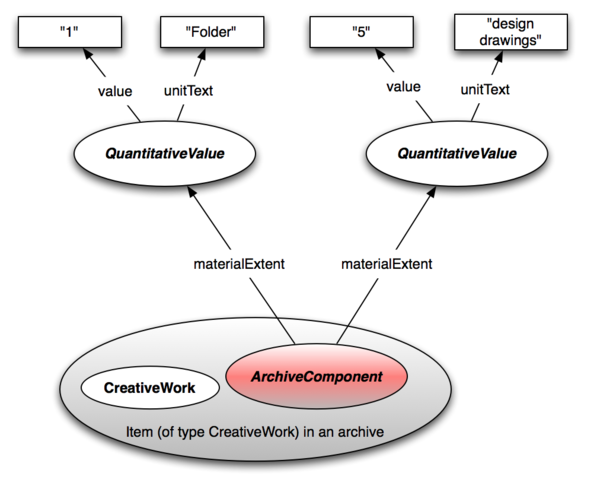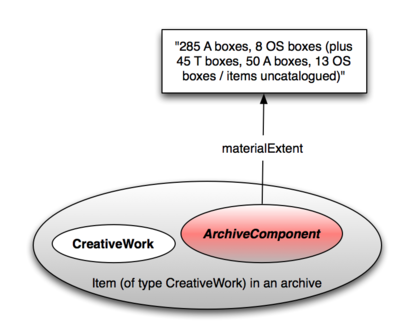Extent proposal
Extent
Introduction
In Archives and Libraries the term 'extent' is used to indicate some aspect of the 'size' of the resource. However, measures of 'size' in this context can vary across different types of material. In the most prevalent metadata formats in archives and libraries, statements of 'extent' are strings of text that may bring together several different measures of size, and include the units as well as any numeric values.
Definitions
In EAD the 'extent' element is defined: the quantity of the materials being described or an expression of the physical space they occupy. Includes such traditional archival measurements as cubic and linear feet and meters; also includes counts of microfilm reels, photographs, or other special formats, the number of logical records in a database, or the volume of a data file in bytes. [
In MARC the 'extent' element is defined: Number of physical pages, volumes, cassettes, total playing time, etc., of of each type of unit.
ISAD(G) uses the term 'extent and medium' and includes the direction: Record the extent of the unit of description by giving the number of physical or logical units in arabic numerals and the unit of measurement. Give the specific medium (media) of the unit of description. Alternatively, give the linear shelf space or cubic storage space of the unit of description. If the statement of extent for a unit of description is given in linear terms and additional information is desirable, add the additional information in parentheses.
Examples
From https://archiveshub.jisc.ac.uk/files/womens/0197_2002.xml (most common 6 extent statements in this file first, then a unique one to show the type of variety that can be present):
- 1 folder
- 1 volume
- 1 item
- 1 object
- 1 tape
- 2 items
- 285 A boxes, 8 OS boxes (plus 45 T boxes, 50 A boxes, 13 OS boxes / items uncatalogued)
From https://archiveshub.jisc.ac.uk/files/rylands/gb133pwr.xml:
- 1 folder; 2 soft-back volumes.
- 1 folder; 5 design drawings.
- 1 hard-back volume, 1 sheet.
- 1 hard-back volume, 41 sheets.
- 1 paper.
- 1 planimetric map.
- 1 sheet and 2 design drawings.
- 1 sheet and 3 design drawings.
- 20 folders + 1 VHS videotape .
From https://www.loc.gov/marc/bibliographic/bd300.html.
- 1 computer disk
- 1 map
- 1 reel (312 ft.)
- 1 score (16 p.)
- 1 sound disc (20 min.)
- 1 videocassette of 1 (Beta) (30 min.)
- 10 boxes (24 linear ft.)
- 149 p.
- 160 slides
- 27 leaves of plates, 4 p.
- 74 p. of ill., 15 p.
- 8 albums (550 photoprints)
- 8 reels of 8 (7557 ft.)
- 95 linear ft.
Proposal
New property: "materialExtent"
Definition: "The quantity of the materials being described or an expression of the physical space they occupy"
Values expected to be one of these types:
- QuantitativeValue
- Text (to allow a string to be used if it is not possible to split out the extent statement into value/unit measurements)
Simple single extent statement
The left diagram represents an extent statement of "1 folder" (using unitText property) The right diagram represents an extent statement of "5 linear feet" (using uses unitCode with the UN/CEFACT Common Code for Linear Foot)
<script type="application/ld+json">
{
"@context": "http://schema.org",
"@type": ["CreativeWork","ArchiveComponent"],
"materialExtent": {
"@type": "QuantitativeValue",
"unitText": "folder",
"value": "1"
}
}
</script>
<script type="application/ld+json">
{
"@context": "http://schema.org",
"@type": ["CreativeWork","ArchiveComponent"],
"materialExtent": {
"@type": "QuantitativeValue",
"unitCode": "LF",
"value": "5"
}
}
</script>
Extent where there are multiple parts to the extent statement
If there are multiple parts to the extent statement, this would have to be represented through multiple materialExtent properties. This diagram represents an extent statement of "1 folder; 5 design drawings."
<script type="application/ld+json">
{
"@context": "http://schema.org",
"@type": ["CreativeWork","ArchiveComponent"],
"materialExtent": [
{
"@type": "QuantitativeValue",
"unitText": "folder",
"value": "1"
},
{
"@type": "QuantitativeValue",
"unitText": "design drawings",
"value": "5"
}
]
}
</script>
Extent as string
Schema.org always allows a string to be used for a property, so it would be possible to publish extent statements without using a QuantiativeValue type. This diagram represents an extent statement of "285 A boxes, 8 OS boxes (plus 45 T boxes, 50 A boxes, 13 OS boxes / items uncatalogued)"
<script type="application/ld+json">
{
"@context": "http://schema.org",
"@type": ["CreativeWork","ArchiveComponent"],
"materialExtent": "285 A boxes, 8 OS boxes (plus 45 T boxes, 50 A boxes, 13 OS boxes / items uncatalogued)"
}
</script>
Extent as the size of a collection
There is a potential case of the extent of a collection as a number of items in the collection. This is true both for the current Collection and the proposed ArchiveCollection subtype in one of the proposals under consideration. To satisfy this requirement a new property collectionSize is proposed for the Collection type with an expected value of Integer and a definition of: The number of artefacts in the collection.
Example:
<script type="application/ld+json">
{
"@context": "http://schema.org",
"@type": ["Collection","ArchiveComponent"],
"collectionSize": "1760"
}
</script>


